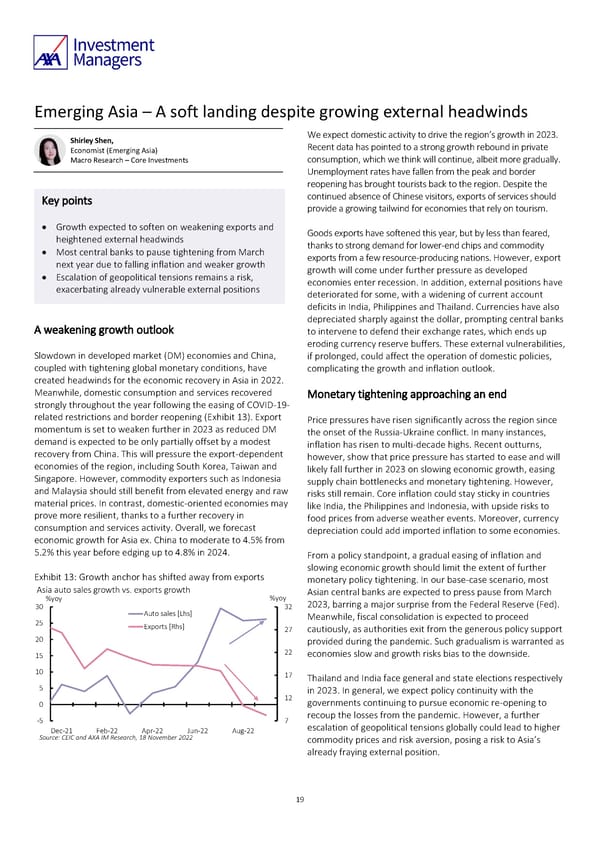Emerging Asia – A soft landing despite growing external headwinds Shirley Shen, We expect domestic activity to drive the region’s growth in 2023. Economist (Emerging Asia) Recent data has pointed to a strong growth rebound in private Macro Research – Core Investments consumption, which we think will continue, albeit more gradually. Unemployment rates have fallen from the peak and border reopening has brought tourists back to the region. Despite the Key points continued absence of Chinese visitors, exports of services should provide a growing tailwind for economies that rely on tourism. • Growth expected to soften on weakening exports and heightened external headwinds Goods exports have softened this year, but by less than feared, • Most central banks to pause tightening from March thanks to strong demand for lower-end chips and commodity next year due to falling inflation and weaker growth exports from a few resource-producing nations. However, export • Escalation of geopolitical tensions remains a risk, growth will come under further pressure as developed exacerbating already vulnerable external positions economies enter recession. In addition, external positions have deteriorated for some, with a widening of current account deficits in India, Philippines and Thailand. Currencies have also depreciated sharply against the dollar, prompting central banks A weakening growth outlook to intervene to defend their exchange rates, which ends up eroding currency reserve buffers. These external vulnerabilities, Slowdown in developed market (DM) economies and China, if prolonged, could affect the operation of domestic policies, coupled with tightening global monetary conditions, have complicating the growth and inflation outlook. created headwinds for the economic recovery in Asia in 2022. Meanwhile, domestic consumption and services recovered Monetary tightening approaching an end strongly throughout the year following the easing of COVID-19- related restrictions and border reopening (Exhibit 13). Export Price pressures have risen significantly across the region since momentum is set to weaken further in 2023 as reduced DM the onset of the Russia-Ukraine conflict. In many instances, demand is expected to be only partially offset by a modest inflation has risen to multi-decade highs. Recent outturns, recovery from China. This will pressure the export-dependent however, show that price pressure has started to ease and will economies of the region, including South Korea, Taiwan and likely fall further in 2023 on slowing economic growth, easing Singapore. However, commodity exporters such as Indonesia supply chain bottlenecks and monetary tightening. However, and Malaysia should still benefit from elevated energy and raw risks still remain. Core inflation could stay sticky in countries material prices. In contrast, domestic-oriented economies may like India, the Philippines and Indonesia, with upside risks to prove more resilient, thanks to a further recovery in food prices from adverse weather events. Moreover, currency consumption and services activity. Overall, we forecast depreciation could add imported inflation to some economies. economic growth for Asia ex. China to moderate to 4.5% from 5.2% this year before edging up to 4.8% in 2024. From a policy standpoint, a gradual easing of inflation and slowing economic growth should limit the extent of further Exhibit 13: Growth anchor has shifted away from exports monetary policy tightening. In our base-case scenario, most Asia auto sales growth vs. exports growth Asian central banks are expected to press pause from March %yoy %yoy 2023, barring a major surprise from the Federal Reserve (Fed). 30 Auto sales [Lhs] 32 25 Meanwhile, fiscal consolidation is expected to proceed Exports [Rhs] 27 cautiously, as authorities exit from the generous policy support 20 provided during the pandemic. Such gradualism is warranted as 15 22 economies slow and growth risks bias to the downside. 10 17 Thailand and India face general and state elections respectively 5 in 2023. In general, we expect policy continuity with the 0 12 governments continuing to pursue economic re-opening to -5 7 recoup the losses from the pandemic. However, a further Dec-21 Feb-22 Apr-22 Jun-22 Aug-22 escalation of geopolitical tensions globally could lead to higher Source: CEIC and AXA IM Research, 18 November 2022 commodity prices and risk aversion, posing a risk to Asia’s already fraying external position. 19
 AXA IM Outlook 2023 full report Page 18 Page 20
AXA IM Outlook 2023 full report Page 18 Page 20